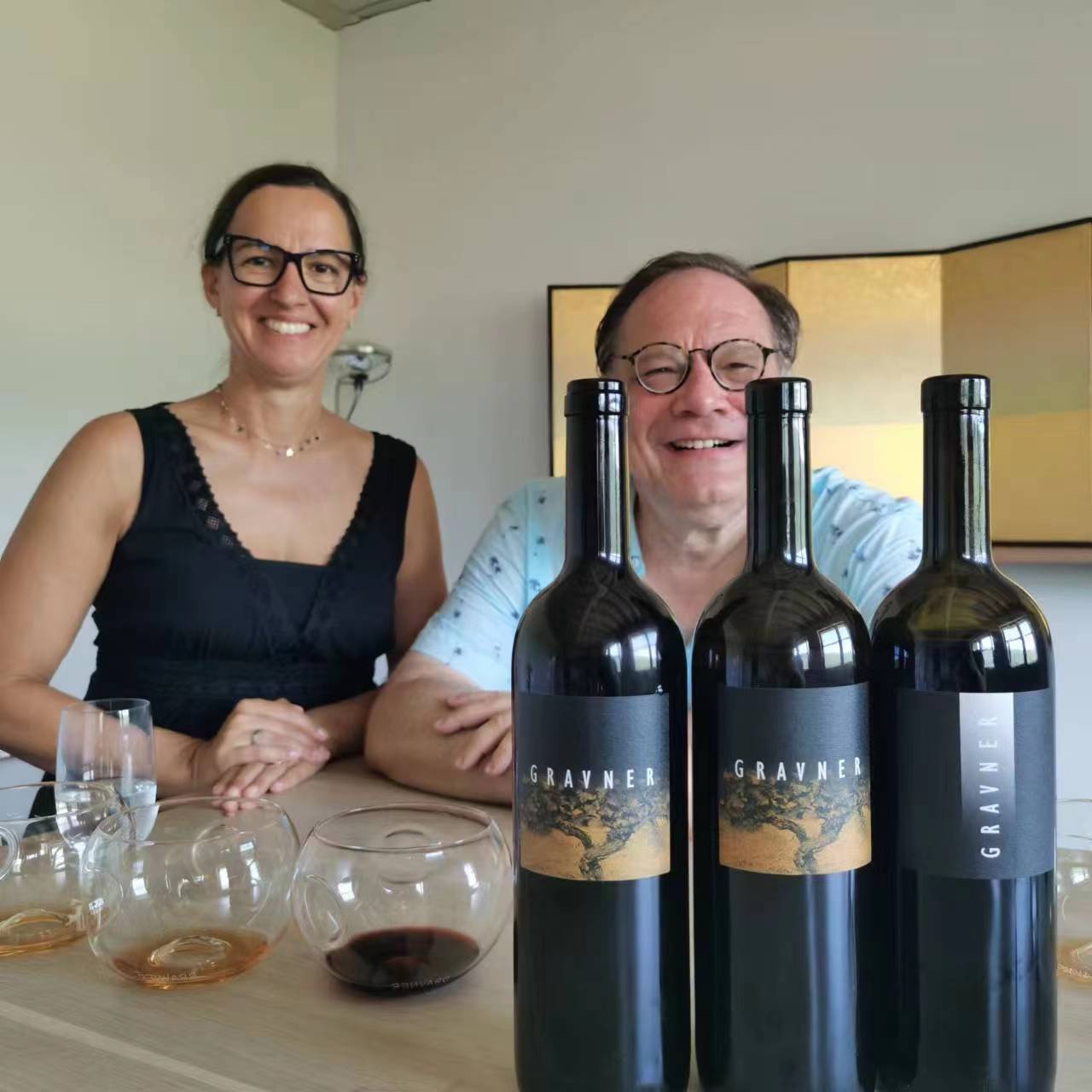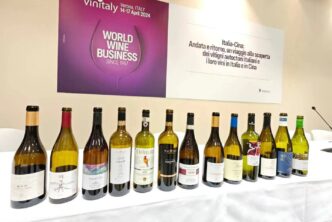毫无疑问,橘酒从起初令人好奇到现在风靡流行,已经成为一种时尚。

虽然橘酒走红全球还是近二十多年的事情,但它们其实一直都在,其历史可以追溯到今天的格鲁吉亚地区,另外古希腊和古罗马通常也会带皮酿造葡萄酒。
如今,橘酒运动发展到现在已被业内人士正式认可和接受,国际葡萄与葡萄酒组织(OIV)于 2020 年制定了相关法规,为橘酒的酿造提供指导意见。
诚然,橘酒不可能是所有人的菜,但其成功已不可否认。这种成功有很多原因。
其中非常重要的原因是:橘酒和另一酒届热门”自然酒”有很高的交集,但和自然酒的暴雷比例相比,大多数(肯定不是全部)橘酒一般都酿造得很好喝,不必担心有时闻起来像满溢的化粪池或死马屁股的味道。
虽然橘酒的起源和复兴运动紧随”自然酒”的发展风潮,但现在酿造橘酒的酒庄也数量不遑多让,而且许多酒庄也同时(或曾经)酿造着世界顶流的”普通”葡萄酒。意大利的Gravner和阿尔萨斯的Domaine Weinbach就是这方面的杰出代表。
橘酒不再小众,也不再需要依靠价格实惠,色彩或鲜艳、或夸张、或卡通和其他噱头来吸引消费者。归根结底,橘酒在很大程度上避免了”自然酒”运动的一些错误,至少在一定程度上解释了它们如今在全球范围内取得成功的原因。
定义橘酒
橘酒是过去我们所知的葡萄酒世界中缺失的一环,其意义超越了单纯的颜色不同。
早先简单化的葡萄酒色彩世界中只存在白色(实际上还有黄色)、粉色和红色,这使得再加上一个橙色并不难。葡萄酒色谱更准确来说有:白色(透明)/绿色(起泡酒)/黄色(白葡萄酒的真正颜色)/桃红色/红色/金色/琥珀色。

橘酒之所以能在葡萄酒世界占据一席之地,肯定不仅仅是因为其颜色。
如果大家静下心来仔细想想,葡萄酒颜色分类里缺失的不仅仅是颜色,还有质地!
从白葡萄酒和桃红酒到红葡萄酒在质地上是相当大的飞跃,前两个类别的葡萄酒通常相当清爽、酒体轻盈,而红葡萄酒则从轻盈、轻松一下到结构庞大。毫无疑问,这其中缺少了一些东西。橘酒不仅比”普通”白葡萄酒色泽更深,而且触感、结构和酒体也更多一筹。
发展到今天,橘酒的风格已经与白、桃红和红葡萄酒一样丰富多彩,从清淡爽口到结构严谨、适于陈年,橘酒也有了许多不同的风格。
橘酒有的平易近人,只有特别轻微的单宁,有的芳香四溢,而有的口感浓郁,单宁不亚于任何巴罗洛或赤霞珠葡萄酒。也正如其他颜色的葡萄酒一样,橘酒本身颜色也有很大差异,有些呈深黄色或勉强呈金黄色,但有些则更偏红,而不是橙色。
另外还有重要的一点是,起泡橘酒的酿造方法也多种多样,有目前非常流行的”pét-nat”、”罐式法”,还有更经典的瓶内二次发酵法。总之,如果您喜欢橘酒,那么这个种类对人们的需求已应有尽有。
回到什么是橘酒,简单的说法是:通过长时间与果皮接触酿造出的白葡萄酒,虽然可能不完全准确。
决定橘酒风格的因素
白葡萄酒是果皮与葡萄汁短暂接触(甚至不接触)后酿造的。橘酒通过增加发酵汁与“白”葡萄果皮接触的时间,使成品酒的颜色大大加深。红葡萄酒不同的色调也来源于与葡萄皮接触的时间,接触时间越长酒的颜色自然越深。但对于所有颜色来说,接触时间总是有限的,否则过多的单宁渗出终会导致酒变得苦涩和不平衡。
果皮接触的时间长短之外,酒的风格和品质还取决于环境温度、葡萄的健康状况和成熟度、所使用的葡萄品种,以及下文会介绍的更多因素。
了解我的读者都知道,我相信葡萄酒总是始于所用的葡萄品种。这是决定所喝葡萄酒的首要鉴别因素,就像咖啡或茶一样。当然软饮不是这样,那是用久经考验的化学/工业配方制成,在世界各地都可以复制,同一款饮料在加拿大、澳大利亚、智利或俄罗斯,味道都是一样的。喝咖啡时是埃塞俄比亚利木豆,还是苏门答腊曼陀林豆,味道大不相同,龙井绿茶或大吉岭红茶显然差别更大。
葡萄酒也是如此:用琼瑶浆酿造的酒,其口感永远不会像用霞多丽酿造的酒那样。对于好的橘酒,也理应如此。
理论上在酿造橘酒时,酒庄通常会选择糖分积累较好的葡萄品种,因为这有助于获得更好的酚类和单宁成熟度。这也意味着橘酒更多由晚收葡萄酿造,能为成品酒带来更多香气和风味多样性。不过,现在大多数酒庄会用他们种植的任何葡萄品种,只要他们认为足够适合这种工艺,所以如今每一种葡萄都能酿造出橘酒。
但如果浸皮霞多丽或白比诺等中性品种,酿造出的橘酒颜色会更深,质地和酒体也比普通酿造、未经橡木影响的中性品种要大得多。这种橘酒在香气和口感上与用麝香和琼瑶浆等芳香品种酿造的橘酒完全不同,后者这些葡萄所富含的多酚(主要是萜烯)不仅使酒质地更好,而且香气扑鼻,芳香四溢。
了解这一点不仅非常有趣,而且非常重要。因为芳香葡萄品种具有丰富的萜烯类物质,而橘酒的酿造方法又能将这些分子真正发挥到极致,因此芳香品种特别适合酿造橘酒。
就像甜酒一样,霞多丽和白比诺,或者说非芳香品种都难成甜酒中的佼佼者,用霞多丽和白比诺等酿造的橘酒也终究少了几分趣味,因为这些酒唯一增强的似乎就是口感强弱和酒体大小。
相比之下,芳香葡萄可以酿造出香气和口感范围更广的橘酒。
话又说回来,如果您喜欢白葡萄酒中的细微差别和细腻口感,那么霞多丽或白比诺橘酒也许会是理想之选。
不过,就算葡萄酒喜好往往因人而异,但对酿酒师来说葡萄品种的选择却有很多讲究。对于橘酒,葡萄品种的重要性远远超出了单纯“我喜欢这种葡萄,所以我喜欢这种酒”的范畴。研究表明,格鲁吉亚的葡萄品种在长时间果皮接触后比其他知名葡萄品种能浓缩更多的酚(如羟基肉桂酸、羟基苯甲酸和类芪),原因尚不清楚,很可能与进化、风土和人为选择有关。
因此,与”经典白葡萄酒”相比,用哪种葡萄酿造对橘酒成品的影响可能会更大。
前文也说道,葡萄品种并不是影响橘酒口味的唯一因素。与葡萄果皮接触的时间长短和温度的高低,都会使酒的口感千差万别。
直觉上,大家会觉得浸皮时间越短,酿出的酒就越细腻,不那么像”大锤”,但事实并非总是如此。果皮较厚的葡萄品种,并不需要太多的果皮接触时间就能酿出浓郁的白/橘酒。但总体而言将果皮接触时间延长到几个月,同时让酒在大桶或木桶中静置熟化,往往会大大改善葡萄酒的单宁结构。
有必要再强调一下,一切都要从葡萄的健康成熟开始,不健康的葡萄或没达到上佳生理成熟的葡萄是一些“坏”橘酒的祸根,涩味重、沙砾感强、苦涩、不干净、不愉悦。为了避免增加葡萄酒的涩味,许多酿酒师现在采用更精细的萃取方式,比如压帽浸皮而不是循环抽汁等。
归根结底,橘酒就像任何”其他”葡萄酒一样:品种、土壤、气候、年份条件和酿酒工艺都在不同程度上影响着葡萄酒的风格。
橘酒的生物化学之路才刚刚开始
长时间葡萄皮浸渍的目的之一是从葡萄皮,包括葡萄籽、葡萄梗和葡萄汁中提取更多的酚。这将有助于加深颜色、提供质感并酝酿不同的香气和风味,但这中间具体发生了什么以及如何在分子水平上发生,仍是许多研究的主题。
一些研究表明,长时间与葡萄皮接触酿造出的葡萄酒有着特别高浓度的flavan-3-ols(主要是儿茶素、表儿茶素或原花青素,果皮的存在似乎有利于(+)- 儿茶素和表儿茶素迁移到发酵的葡萄汁中)。在另一些研究中,当浸渍时间从7天增加到21天时,原花青素 B1、原花青素 B3 和(+)-儿茶素的浓度会降低或趋于稳定,不过一些研究表明原花青素 B2、表儿茶素和原花青素 C1 的浓度会随着果皮接触时间的延长而增加。
长时间的果皮接触也会带来负面影响,比如葡萄酒过于苦涩、颜色呈令人不快的棕色。褐变主要是由于多酚氧化酶等酶的浓度过高,以及表皮接触时间过长导致葡萄汁中酚浓度升高。
此外,让固形物与葡萄汁保持接触也会导致葡萄酒出现过早氧化的特征。如果这种气味是雪利酒或Vernaccia di Oristano葡萄酒的典型特征,那还好;但如果尝起来只是氧化了,那就不是什么好事了。例如,大多数意大利酒庄不会选择用Verdicchio和Greco葡萄酿造需要长时间果皮接触的葡萄酒的原因之一就是,这两种葡萄的果皮单宁含量很高,用这两种葡萄酿橘酒实在是自找麻烦。
当然,总有人会迫不及待地向我们展示他或她有多么聪明或与众不同,所以现在已经可以看到浸皮的Verdicchio葡萄酒,而这不正是我们这个自由多彩的世界所需要的吗?
橘酒现在和未来都将是许多研究的主题,因为橘酒仍相对新颖,诸如提取单宁的确切数量、浸渍时间与果皮用量的比例,以及这些参数适用于哪些风格等问题,在很大程度上仍是百家争鸣。
橘酒的问题
橘酒的酿造方法与传统白葡萄酒相比,还呈现另外一些特征。
长时间与果皮接触酿造的葡萄酒,总酸度通常会明显降低。这种降低很可能是酒石酸钾沉淀的结果,由于葡萄皮钾含量高和/或缓冲效果的积累,酒石酸钾含量升高产生更多沉淀,从而降低葡萄酒酸度。
还有,橘酒的口感会更柔和,因为长时间与葡萄皮接触会导致苹果酸转化为乳酸。相比不与果皮接触的发酵,其乳酸转化的速度也更快,因为葡萄固形物中含有各种乳酸菌,它们能愉快地帮助完成苹乳转化。
这些引出了橘酒一个比较现实的问题,经常饮用此类葡萄酒的人都清楚:挥发酸。橘酒中挥发酸的增加是众所周知的,但其确切机制还不完全清楚,可能是由于前面提到的酒长期处于氧化环境中所造成。
至少对大部分葡萄酒爱好者来说,橘酒还有一个公认的问题。凭借丰富的经验,很多人可以合理筛选出橘酒可能的风格,但真要确定喝的到底是什么,则完全是另一回事。
这也是许多人对橘酒的重点批评之一:由于橘酒的酿造果皮浸渍时间长,葡萄分子和提取的化合物随着时间推移总在发生变化。这种变化的程度往往与正常情况下酿造的葡萄酒完全不同。
我甚至见过不止一位橘酒的生产商或葡萄酒”专家”混淆手中的酒,在品尝时完全不知道自己说的到底是哪种酒。还有一些大名鼎鼎的人物在品尝过程中不小心把Ribolla Gialla和Friulano的酒杯颠倒过来,但仍在滔滔不绝地谈论着,丝毫没意识到这两种酒完全不同。

这种情况非常普遍,对于所有喜欢辨别葡萄酒的人来说,这就会是一个问题。毕竟,这批购买葡萄酒的人们,喜欢辨别在奥斯拉维亚(Oslavia)和格拉夫(Grave)酿造的Ribolla Gialla葡萄酒,在韦斯塔尔腾(Westhalten)和里克威尔(Riquewihr)酿造的琼瑶浆葡萄酒之间有什么不同之处。
此外,几个世纪以来,葡萄酒也一直在和欺诈行为作斗争,如果一种新的葡萄酒风格,却没人能够可靠地辨认出这种酒是用哪种葡萄酿造?或者确切产地是哪里?可能会让很多人对未来感到失望。
当然,绝大多数酿酒师都是非常优秀的人,热爱自己的手艺,每天、每周、每月、每年都从事着一项伟大、值得称赞的工作;但也得承认,对于那些容易混淆葡萄特性或产地的葡萄酒,人们多少会有一些小小的担忧。
橘酒是这个时代葡萄酒世界令人兴奋的新东西,但又非常”老”。如果能多一些真正的好酒,比如Josko和Mateja Gravner夫妇酿造的神奇Riboalla,那么,世界上伟大的葡萄酒会有更多伙伴。

 English
English




Ian–you have done the wine world a service with your comprehensive essay on Orange wines. It should be mandatory reading for anyone making and selling orange wines!
Thanks, I actually had fun writing it, like I do with any topic that becomes faddish and way too many people jump on the banwagon without ever turning their brain switches to “on”.
I have an incredible number if thought-provoking anecdotes and stories on Orange wines I could write about, and maybe I will one day gain. But two episodes really stand out, that are clearly serious food for though because they were both about the exact same thing. Both a super-famous writer and proponent (super-famous in the realm of orange and natural wines only, that is) and one of the wold’s five or so best-known orange wine producers clearly cannot recognize what they have in the glass. Both inadvertently mixed their glasses up at two different tastings and didn’t catch on the rest of the day. Frankly, it wasn’t just embarrassing, it was also telling that with orange wines being made the way they are, recognizing grape variety is almost moot. And why anyone would think that turning wine into a soft drink, that akways tastes the same no matter where it’s made, is beyond me.